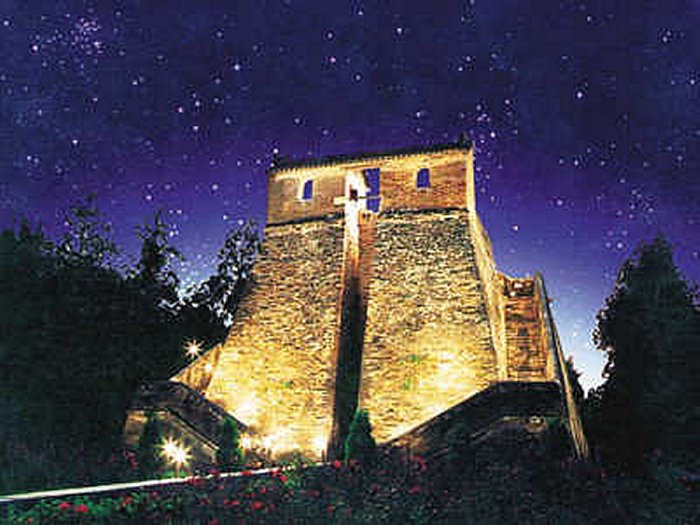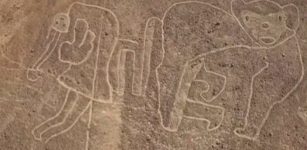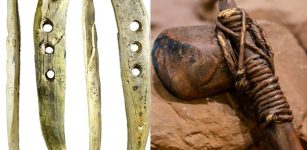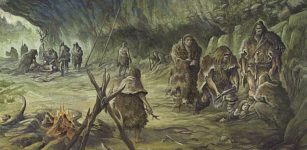Gaocheng: China’s Oldest Observatory And Large Gnomon Installation Of The Ancients
A. Sutherland - AncientPages.com - Astronomical tradition of ancient China was an important part the country’ cultural tradition and dates back to the Bronze Age and 1800 BC. Through the millennia, it changed, but the core – the basic pattern of the Chinese astronomy – remained the same.
To early astronomical observations – especially the passage of the sun - the Chinese used a simple but very powerful instrument known as ‘gnomon’.
The Chinese used a ‘gnomon’ instrument as it was confirmed by archaeologists who discovered the early graphic symbol that represents an idea or perhaps a concept of this useful instrument on Bronze Age oracle bones of Shang Dynasty.
Several accounts of Chinese gnomons – before and after the birth of Jesus Christ – also confirm their use. For example, one such large ‘gnomon installation’ existed at Yang-Cheng town, (now Gao-cheng (Gaocheng), located about 50 miles south east of Louyang, (then, the capital of the Eastern Han Dynasty (25-220 AD).
See also:
Gnomon: Ancient Time Measuring Instrument Used By Babylonians, Egyptians And Chinese
Ancient Genius Jang Yeong-sil And His Brilliant Astronomical Instruments
Probably The Oldest Star Map Discovered In Stone Chamber Of The Kitora Tomb, Asuka Nara, Japan
Elusive Planet Mercury As Seen Through The Eyes Of Ancient Astronomers
Namoratunga: ‘People Of Stone’ And Ancient Astronomical Observatory
The Gaocheng Observatory situated at Dengfeng in the central Chinese province of Henan, is a historic solar observatory with a long tradition: it also has a very powerful structure.

The structure has trapezoidal shape and was constructed of bricks and stones; it is composed of two main parts the body and shigui (‘the ruler to measure the sky’).
It is the oldest astronomical platform in China with tradition that goes back to the time of the Mongol rule. It was built from 1267 to 1269 during the Yuan Dynasty (1271-1368), when the Empire of Yuan was established and it was used for observations of the stars, the sun and for recording of time.
The structure is also one of the most ancient observatories in the world.
Additionally, there have been commissioned the construction of 27 observatories the so-called 'observation stations' scattered across the China.
The Gaocheng Observatory played an important role because it was determined to be the 'earth core', which means the most central point on the surface on our planet. It delivered very precise observations.

Astronomical tradition of ancient China was an important part the country’ cultural tradition and dates back to the Bronze Age and 1800 BC
The structure has trapezoidal shape and was constructed of bricks and stones; it is composed of two main parts the body and shigui (‘the ruler to measure the sky’).
It is 9.46 meters high by itself, and 12.62 meters high if the 2 cabinets on the top are included. The somewhat unconventional gnomon is a bar mounted horizontally between the 2 cabinets. The shigui extending to the far north is 31.9-m-long stone measurement path that stretches out in front of the building and is used to measure the sun's shadow.
It is made up of 36 square stones with two parallel waterways on it to check its levelness. The location of shigui is in accordance with the direction we take today to measure the Meridian. External stairway lead to the structure’s top.
Gaocheng Observatory was designed by Guo Shoujing (1231-1314) who was an inventor, mathematician and astronomer. He used his engineering skills to advance several instruments indispensable for measuring of celestial bodies.
Written by – A. Sutherland - AncientPages.com Senior Staff Writer
Copyright © AncientPages.com All rights reserved. This material may not be published, broadcast, rewritten or redistributed in whole or part without the express written permission of AncientPages.com
Expand for referencesReferences:
F. Wang, Geo-Architecture and Landscape in China’s Geographic and Historic Context
More From Ancient Pages
-
 Londinium: Ancient Roman Outpost That Became Powerful City Of London
Featured Stories | Aug 16, 2018
Londinium: Ancient Roman Outpost That Became Powerful City Of London
Featured Stories | Aug 16, 2018 -
 Drones Discover 25 Never-Before-Seen Geoglyphs Near Famous Nazca Lines
Archaeology | Jun 4, 2018
Drones Discover 25 Never-Before-Seen Geoglyphs Near Famous Nazca Lines
Archaeology | Jun 4, 2018 -
 Oldest Olive Oil Press Facilities Owned By Mysterious Woman ‘Arete’ Unearthed In Antalya, Turkey
Archaeology | Apr 2, 2017
Oldest Olive Oil Press Facilities Owned By Mysterious Woman ‘Arete’ Unearthed In Antalya, Turkey
Archaeology | Apr 2, 2017 -
 Wonderful Long-Lived Nymphs In Greek And Roman Mythologies
Featured Stories | Mar 29, 2024
Wonderful Long-Lived Nymphs In Greek And Roman Mythologies
Featured Stories | Mar 29, 2024 -
 The Maasai Legend Of Hero Lakalanga And His Ancient Footprints
African Mythology | Jul 12, 2019
The Maasai Legend Of Hero Lakalanga And His Ancient Footprints
African Mythology | Jul 12, 2019 -
 Wayland The Smith: Legendary Master Blacksmith And Lord Of The Elves
Featured Stories | Jul 14, 2016
Wayland The Smith: Legendary Master Blacksmith And Lord Of The Elves
Featured Stories | Jul 14, 2016 -
 Rare Mammoth Ivory Tool Offers Evidence Of Ropemaking In Central Europe More Than 35,000 Years Ago
Archaeology | Feb 5, 2024
Rare Mammoth Ivory Tool Offers Evidence Of Ropemaking In Central Europe More Than 35,000 Years Ago
Archaeology | Feb 5, 2024 -
 Unknown Sketch Of Jesus Christ By Leonardo Da Vinci Could Be The Holy Grail Of Art
News | Nov 24, 2020
Unknown Sketch Of Jesus Christ By Leonardo Da Vinci Could Be The Holy Grail Of Art
News | Nov 24, 2020 -
 Neanderthals Buried Their Dead – New Evidence
Archaeology | Dec 10, 2020
Neanderthals Buried Their Dead – New Evidence
Archaeology | Dec 10, 2020 -
 Asgard: Enter The Ancient Kingdom Of The Powerful Norse Gods
Featured Stories | Aug 7, 2016
Asgard: Enter The Ancient Kingdom Of The Powerful Norse Gods
Featured Stories | Aug 7, 2016 -
 Tantalus – Greek King And Evildoer Who Violated Divine Laws And Was Sent To Tartarus
Featured Stories | Mar 1, 2019
Tantalus – Greek King And Evildoer Who Violated Divine Laws And Was Sent To Tartarus
Featured Stories | Mar 1, 2019 -
 Ground-Breaking Discovery: A 3,300-Year-Old Deep-Sea Canaanite Shipwreck Found
Underwater Discoveries | Jul 3, 2024
Ground-Breaking Discovery: A 3,300-Year-Old Deep-Sea Canaanite Shipwreck Found
Underwater Discoveries | Jul 3, 2024 -
 Treasure Trove Of Assyrian Kings Found In Tunnels Excavated And Plundered By Terrorists
Archaeology | Apr 20, 2020
Treasure Trove Of Assyrian Kings Found In Tunnels Excavated And Plundered By Terrorists
Archaeology | Apr 20, 2020 -
 Ancient City Machu Picchu Was Originally Called Huayna Picchu By The Incas – Study Of The Name Reveals
Archaeology | Mar 23, 2022
Ancient City Machu Picchu Was Originally Called Huayna Picchu By The Incas – Study Of The Name Reveals
Archaeology | Mar 23, 2022 -
 Enigmatic, Grand Neolithic Dolmen Roche-aux-Fées Built By Fairies And Steeped In Aura Of Love And Hope
Featured Stories | Jan 9, 2025
Enigmatic, Grand Neolithic Dolmen Roche-aux-Fées Built By Fairies And Steeped In Aura Of Love And Hope
Featured Stories | Jan 9, 2025 -
 On This Day In History: First Siege Of Rome Began – On March 2, 537
News | Mar 2, 2017
On This Day In History: First Siege Of Rome Began – On March 2, 537
News | Mar 2, 2017 -
 Iraq’s Ancient Kish City Survived The Great Flood – Today It’s Neglected And Lies Buried In Sand
Civilizations | Sep 24, 2015
Iraq’s Ancient Kish City Survived The Great Flood – Today It’s Neglected And Lies Buried In Sand
Civilizations | Sep 24, 2015 -
 Mysterious Disappearance Of Louis Le Prince – Murder And Cover-Up?
Featured Stories | Jun 27, 2020
Mysterious Disappearance Of Louis Le Prince – Murder And Cover-Up?
Featured Stories | Jun 27, 2020 -
 5,000-Year-Old DNA Could Solve The Mystery Of Genetic Changes In Europe
Archaeology | Mar 8, 2022
5,000-Year-Old DNA Could Solve The Mystery Of Genetic Changes In Europe
Archaeology | Mar 8, 2022 -
 Cinnabar And Hematite Were Used In Early Teotihuacan Murals – INAH Researchers Say
Archaeology | Aug 5, 2020
Cinnabar And Hematite Were Used In Early Teotihuacan Murals – INAH Researchers Say
Archaeology | Aug 5, 2020

